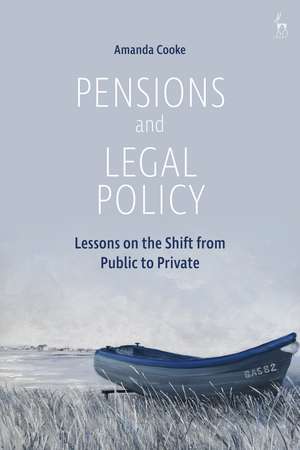Pensions and Legal Policy: Lessons on the Shift from Public to Private
Autor Amanda Cookeen Limba Engleză Paperback – 19 oct 2022
| Toate formatele și edițiile | Preț | Express |
|---|---|---|
| Paperback (1) | 250.55 lei 6-8 săpt. | |
| Bloomsbury Publishing – 19 oct 2022 | 250.55 lei 6-8 săpt. | |
| Hardback (1) | 468.00 lei 6-8 săpt. | |
| Bloomsbury Publishing – 10 feb 2021 | 468.00 lei 6-8 săpt. |
Preț: 250.55 lei
Preț vechi: 322.53 lei
-22% Nou
Puncte Express: 376
Preț estimativ în valută:
47.95€ • 49.87$ • 39.58£
47.95€ • 49.87$ • 39.58£
Carte tipărită la comandă
Livrare economică 14-28 aprilie
Preluare comenzi: 021 569.72.76
Specificații
ISBN-13: 9781509944729
ISBN-10: 1509944729
Pagini: 272
Dimensiuni: 156 x 234 mm
Greutate: 0.35 kg
Editura: Bloomsbury Publishing
Colecția Hart Publishing
Locul publicării:London, United Kingdom
ISBN-10: 1509944729
Pagini: 272
Dimensiuni: 156 x 234 mm
Greutate: 0.35 kg
Editura: Bloomsbury Publishing
Colecția Hart Publishing
Locul publicării:London, United Kingdom
Caracteristici
Ground-breaking examination of the different social costs relating to the form and content of regulatory intervention underpinning the Auto-Enrolment pensions regime
Notă biografică
Amanda Cooke is a pensions lawyer and Guest Lecturer at the University of Edinburgh Law School, UK.
Cuprins
1. An Introduction to the Work I. Background II. Pensions A. Public Sector Pensions B. Private Pensions: Occupational Pension Schemes III. Key Policy Considerations IV. The Road to Auto-Enrolment: The Rise and Fall of Voluntary Private Pensions V. The Road to Auto-Enrolment: The Pensions Commission VI. Lessons from Abroad VII. Conclusion 2. Introduction of Auto-Enrolment to the UKI. Auto-Enrolment and Parliamentary Intent A. Increase Saving by Default B. Prevent a Reduction in Existing Pension Benefits or Levelling Down C. Education of the Workforce D. Private Pension Saving Compatible with State Benefits II. Legislative RealityIII. Post Implementation Legislative Changes A. Value B. Costs and Charges C. Scheme Governance D. Master Trusts E. Taking Pension Benefits IV. Conclusion 3. Legal Paternalism and the Auto-Enrolment Regime I. Introduction II. Autonomy v Law III. Legal Paternalism A. The Rise of Paternalistic Legislation IV. Soft Paternalism or Nudge V. Paternalism and Contracts VI. Intention of Legal Intervention VII. Proof and Value Measurement VIII. Conclusion 4. The Role of Behavioural Economics in Legal Intervention I. Introduction II. Behavioural Economics A. Inertia and Procrastination B. Framing and Presentation C. Social Influences D. Difficulties in Assessing Probability III. The Influence of Behavioural Economics on Law and Policy IV. Regulatory Intervention and Choice Architecture A. Policy of Legal Paternalism B. Choice Architects C. Alternatives to Soft Paternalism/Choice Architecture V. Auto-Enrolment as Choice Architecture A. Auto-Enrolment B. Opting-out C. Defaults D. Auto-Enrolment and Behavioural Bias E. Framing and Disclosure VI. Conclusion 5. Empirical Research Findings I. Introduction to the Research II. Research Design and Methodology III. Findings A. Action B. Barriers to Decisions C. Intervention and Implementation D. Engagement and Understanding E. Trust IV. Conclusion A. Choice and Defaults B. Understanding C. Information D. Individual Perception of Auto-Enrolment E. The Employee/Employer Relationship and Auto-Enrolment F. Impact of Gender and Age G. Negative or Unforeseen Consequences of Auto-Enrolment 6. Unintended Consequences: Remedies I. Introduction II. Fiduciary Duties Owed to Employees A. When Do Fiduciary Obligations Exist? B. The Consequences of Fiduciary Obligations III. Duties Owed by the Employer as an Agent A. The Agency Relationship B. Consequences of Agency IV. Duties Arising from the Contract of Employment A. Implied Terms B. Auto-Enrolment Compliance and the Contract of EmploymentV. Duties Owed to the Employee by the Pension Provider or Advisors A. Provision of Advice B. Misunderstandings and Mis-statements C. Third Party Liability D. Reliance on Financial Regulation VI. Conclusion 7. Conclusion I. Why Do We Have Auto-Enrolment? A. The Ageing Population B. Combat Behavioural Traits II. Choice Architecture and Justification A. Intervention not Persuasion B. Behavioural Economics III. Has Legislative and Practical Implementation Reflected the Policy Intention? A. Defaults B. Employer Discretion C. Communication and Active Choice IV. Are There Unforeseen or Unintended Consequences and How Do These Affect Justification for Legal Intervention? A. Barriers and Misunderstandings B. Reliance on Defaults C. AdviceD. Detriment and Responsibility E. Social Costs and Remedies
